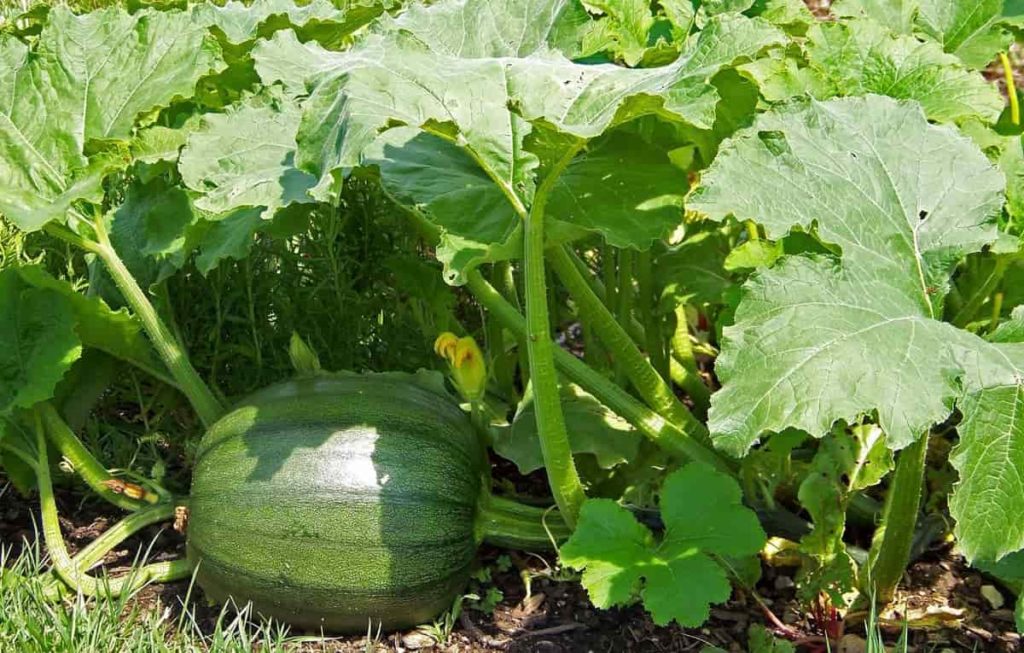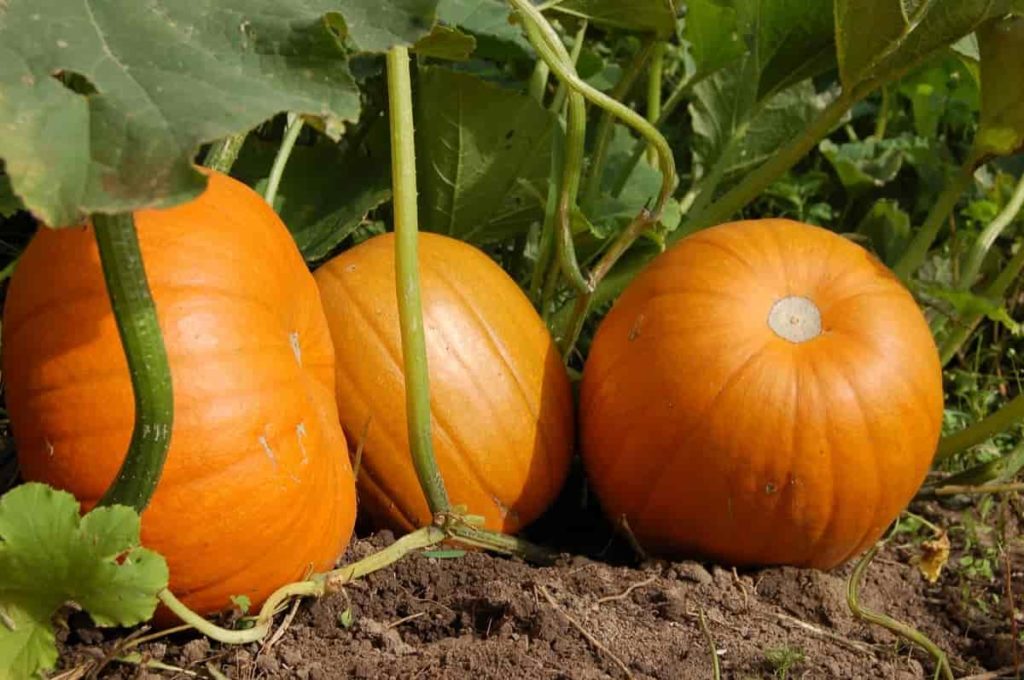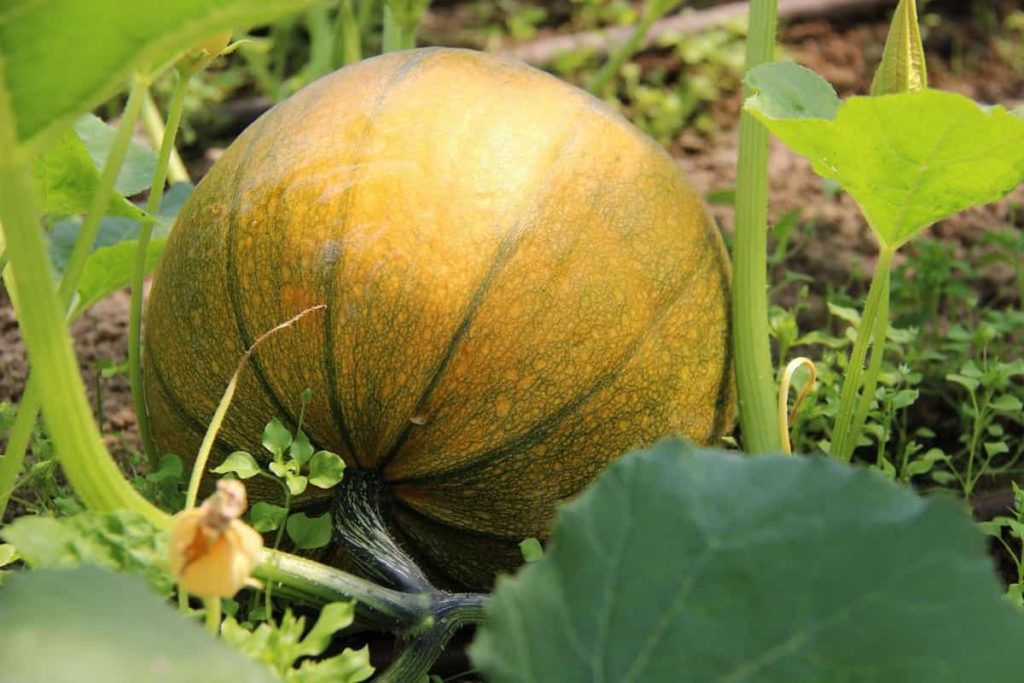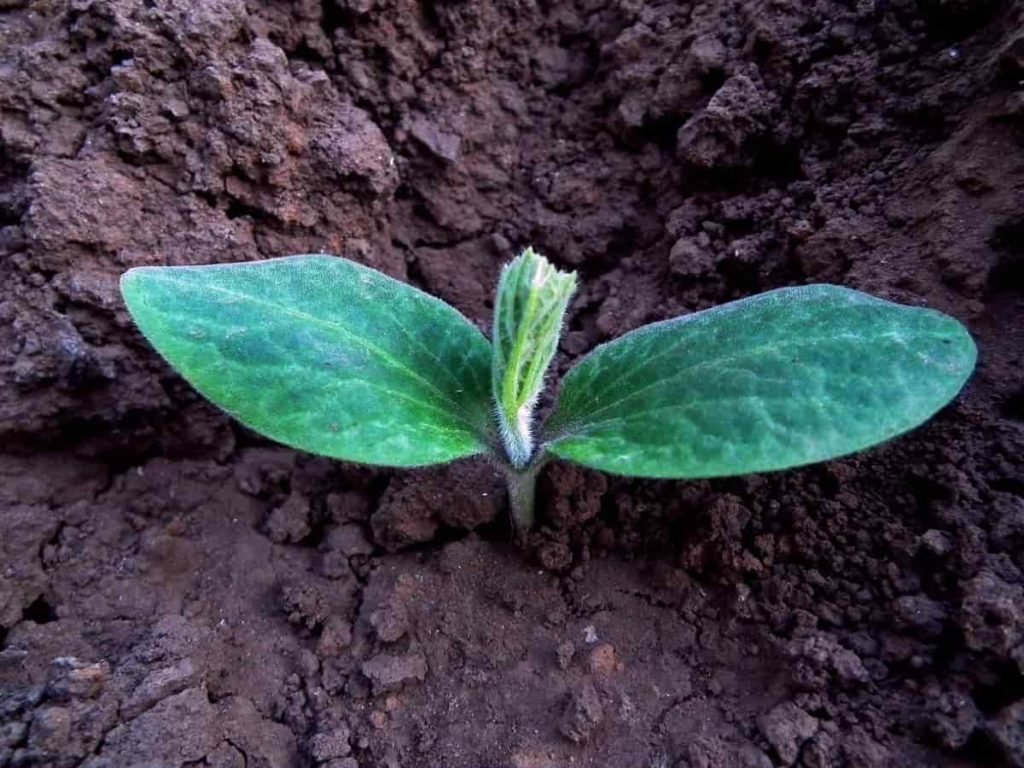Pumpkins need moisture for the best growth, but they can’t tolerate much-wet soil filled with mud and water after rain or irrigation. Rich, loamy-soiled sites usually maintain maximum drainage and moisture so that the ground maintains the right amount of moisture. Sandy soil drains quickly, and heavy soil drains poorly; both benefit from adding organic matter, such as manure or leaf mold, worked in the garden before planting Pumpkin. Let’s check out the soil preparation for Pumpkin plants below.

Give enough space to your Pumpkin patch and prepare your bed early. It is possible to plant it directly in your garden soil, or preferably, you can prepare a specific bed for your Pumpkin, leading to better results. To prepare a clay bed for Pumpkin, choose the size of the area you’re going to prepare (keeping in mind Pumpkin plants will need a good space, the vines can run 25 feet or more) and dig two to three feet down and then backfill with a rich compost and fertilizer mix.
Do not compact the soil when backfilling and avoid areas where vine crops have been grown earlier. Next, pay attention to the area around your Pumpkin patch where your Pumpkin vines will grow. Pumpkin vines will establish roots, and rich soil beyond the bed should improve Pumpkins. Pumpkins perform well in pH-neutral soil, and soil tests indicate whether your soil needs work.
Soil preparation for Pumpkin plants
Soil pH for Pumpkin
Soil testing is an important way to learn nutritional levels, pH (or acidity), and organic matter in the soil. Many soil testing reports will include recommendations for improving soil for specific crops, including Pumpkins. It is better to use your soil test to plan your fertilizing regimen, as fertilizer is not required to be added. Likewise, your plants do not need so Pumpkins can focus more on vegetative growth than flowers and fruits, cause fruit distribution, and even lead to disease problems.
Good quality soil also requires the right acid and alkaline balance, indicated by the soil pH. A simple soil test can determine the pH and give you time to adjust it before planting. For example, pumpkin needs a pH between 6 and 6.5 for healthy growth. Established vegetable beds likely fall within this limit, but new beds may need to be modified. Agricultural lime amendments increase pH while ammonium sulfate reduces it. The soil test provides a recommendation on which is to be used and the amount of inclusion.
In case you missed it: Best Fertilizer for Pumpkin: Homemade, Organic, Liquid, Compost Manure, NPK, and Schedule

Preparation of soil for growing Pumpkin in containers
In a cold climate, Pumpkins grow best in soil that gets easily heated. In addition, pumpkins reach some larger sizes. So, these plants require a lot of nutrients, and it is essential to have soils with high humus materials. The potting mix you use should be well-draining; it should have high humus and a modest ability to maintain water. Also, Pumpkin needs a lot of organic matter like compost or manure, which you can add at planting. Water is also maintained in compost. Mix compost in your soil before planting, then apply more manure on top of the soil after planting.
Preparation of soil for growing Pumpkin on grounds
Preparing soil on the bed where your Pumpkin seedlings are planted, and the main root is very important. But, soil preparation around the entire area where the Pumpkin vine will spread is equally essential. The soil condition beyond the bed is important as Pumpkin sends secondary roots with the whole vine system. Enriching the soil wherever the vine travels benefit large Pumpkins. You should choose soil rich in nutrients and neutral in pH.
Add soil amendments such as manure and compost in generous parts. Mix the amendments in the existing soil well. You cannot put too much manure and compost in the area where Pumpkins will grow. At the same time, you may not make the soil so rich nor add amendments as deeply as a planting space for the seedlings. It’s just too much work. Just remember to make sure that everything you add is entirely rotten.
Pumpkins are heavy feeders. They like rich clay and lots of it. Many farmers who grow Pumpkins focus on creating a rich base for Pumpkin roots. Pumpkin growers swear by making a layered planting mound using compost, straw, leaf mulch, and composted manure. If you are doing this near planting time, remember to use composted manure. But if you know where you will grow Pumpkin next year, use fresh manure a few months ahead of time in the planting area. By taking the time, it will be decomposed.
In case you missed it: Pumpkin Gardening For Beginners, How To Start, FAQs

How to grow Pumpkin in clay soil
Long-term planning
The best time to think about soil improvement is before planting your Pumpkin seeds. You can grow Pumpkin directly in clay soil but make some changes to the soil first for best results. Then, take some simple steps to improve the basic structure of the soil. It will be suitable for Pumpkins and for whatever crop you want to grow in the coming seasons. Use well rotten manure, and layer it on the soil in the autumn to start working in the soil in winter.
Apply a lot of organic material to dissolve in the soil over time. Manure enriches the soil with nutrients. It breaks the soil to support the growth of ideal plants. Moreover, you can introduce worms into the soil instead of the garden. The worms will break and fuel the layers of soil. Worms also feed organic material that you have added to the soil and will release castings. Worms help by adding a lot of nutrients to the soil.
Gypsum and compost can naturally help bring worms to your garden. In addition to attracting insects, adding gypsum to the soil also improves its texture. Gypsum pushes the soil particles away from each other. As a result, it provides more drainage and water retention.
Short-term Planning
Don’t worry if you don’t have time to improve the soil structure. They will not mind the soil until they grow in rich, well-drained planting holes. Pumpkins are deep-rooted plants. Dig a hole one foot deep, 2 to 3 feet wide in the ground. To fill the hole, mix the soil above several modifications of holes, compost, and soil together.
Pumpkins are heavy feeders, and from the onset of the growing season, they will need a good mix of nutrients to grow from nutrition. For each planting hole, mix the following material into the soil and manure above before adding to the hole:
- 1/2 cup blood meal
- 1 cup bone meal
- 3/4 cup Greensand
- 1/4 cup hardwood ash
- 1/3 cup kelp powder
- 2 tbsp pelleted sulfur
- 2 tbsp lime
In case you missed it: Pumpkin Seed Germination, Time, Temperature, Process

It is a recommended list of amendments you can add for the tremendous growth of Pumpkins.First, filll the hole with the clay mix as you wish and set the Pumpkin transplant to the center. Next, cover the roots with a soil mix and create a moat around the plant to maintain efficient water. When growing Pumpkins in clay soil, you will need to be more careful while watering. Pumpkins usually require one inch of water every week.
One of the advantages of clay soil is that you may need less water to prevent the garden from staying wet. However, water-filled soil is not suitable for Pumpkins and will promote root rot. Always poke your finger in the soil to check if it is moist before any water is offered. Spread a level of mulch in plants to improve drainage.
Soil composting for Pumpkin
Soil improved with a thick layer of added organic matter will offer the best fruits. Soil rich in humus or any completely rotten material such as garden compost or animal manure will sustain more moisture during dry weather. Humus also acts as a buffer between the water, maintaining stable and predictable conditions in the root area.
Constant moisture of the soil is essential as the sudden influx of liquid, especially after a dry spell, causes fruit to burst. You can add more organic matter to the soil surface in the form of mulch and lock in more soil moisture while providing extra goodness for rooting the Pumpkin stem.
Land preparation for Pumpkin
Pumpkins are usually seeded in the ground during the first two weeks of July. Since these are hot weather crops, they should not be seeded until soil temperature reaches 15°C three inches below the soil surface. Pumpkin seeds in cold soil may suffer from corn-maggot injury. Your soil should prepare well for Pumpkin growing to get high production. So, to prepare the soil for Pumpkin, bring your soil in fine tilth form.
In addition, you should also be level it. Remove all plant debris. Pumpkins are usually grown in small hills. Prepare the hills by leaving a trench of about half a foot to keep water around the plant roots. If you plan to put up more than one hill, make sure they are at least ten meters away. The mounding will allow better drainage, and the raised soil enables the seedlings to and the soil around it to heat better on cold days.
Note that if there is any fertility deficiency in your soil, they should be completed at the time of soil preparation, as are better results in production. In addition, adding all essential organic matter with a proper dose of manure to your chosen site will always benefit you. Dig pits 60 centimeters in diameter and depth 30 to 45 centimeters and maintain a 4.5 X 2.0 meters distance. You should mix well-rotten farmyard manure and compost with topsoil in the pit.
In case you missed it: Growing Pumpkins from Seed at Home – A Full Guide

Best soil mix for Pumpkin
Pumpkins prefer rich, well-drained soil. You should use a light potting mix with vermiculite, perlite, or peat moss. Before planting, a good amount of organic material is recommended to be mixed, such as manure or peat moss.
Natural soil amendments for Pumpkin
Manure is decomposed animal waste that provides nitrogen and other essential nutrients to the soil. It is good for Pumpkins, but animal-based manures, in general, are very good for all kinds of plants. You can also buy a bone and blood meal, which provide organic nutrients in specific proportions. Fish emulsion is a popular fertilizer that provides a balanced NPK ratio with plant roots. But composted manure is not necessarily considered fertilizer only as those others, although it provides many resources.
It is considered both soil modification and fertilizer. It means you can add it to your regular soil ratio before planting. It is undeniable that well-composted manure is one of the best things that you can add to your soil. Any organic manure will usually work to boost nutrition in your Pumpkin patch. Although the most common type is cow and horse manure, you can also use commercially sold chicken manure or bat guano. First, however, you can use the most common cow and horse manure.
Cow manure is better because cows process their food more effectively than other animals, and horse manure contains many small seeds. Hence, cow manure is preferred for the control of weeds. But once you have modified with manure to prepare your soil, you can take it a step further by looking at a compost tea recipe which you can spray every week and feed the nutrients directly into your Pumpkin plant leaves.
Almost every vegetable, including Pumpkin, thrives on compost-rich soil. You can throw everything from leaves and grass clippings to vegetable scraps in your compost pile. Most gardeners know that it is essential never to include table scraps with animal matter composition, but you need to point it out if you are new to gardening. It is also essential to ensure that the things you put in your compost pile are free from plant diseases.
If your compost is not hot enough, it probably affects the disease in your next Pumpkin crop again. Most leaves are neutral in pH and are generally healthy for soil and your Pumpkin, making them a frequent addition to a garden. It would be best to choose oak and maple leaves. However, you need to be careful as all leaves will not be good for your Pumpkin.
In case you missed it: Soil Preparation for Onion Plants: Best Soil Mix, pH, and Compost

What to do with soil when growing Pumpkin
Since lack of pollination is the main cause of poor production, encouraging bees to visit Pumpkins by planting Borage, Nasturtiums, Rosemary, Oregano, and other heat-tolerant, bee-attracting herbs, and plants. Allowing vegetables like Radish and Carrot to flower and stay in your garden during spring and summer can also attract flies and help with pollination. Avoid planting root crops near Pumpkins, such as Beetroot, Onions, and Potatoes, which can disturb sensitive Pumpkin roots when harvesting.
The main concern with planting companions for Pumpkins is that with vigorous growth, long vines, and a wide habit of many varieties, Pumpkin plants can overwhelm, cover and starve other plants by blocking sunlight. Therefore, pumpkin vines are generally not recommended for interplanting. Pumpkin can be successfully grown from tall or large columnar plants such as Sunflower, Amaranth, and giant corn.
- How to Grow Hibiscus from Flower
- Plantation Ideas for Home Decoration: A Beginners Guide
- Flower Garden Designs and Layouts for Beginners
- Planting and Spacing Techniques in Papaya: A Beginner’s Guide
- Growing Gold: Essential Techniques for Planting Pineapples
- How to Make Kalanchoe Plant Bushy: Home Remedies and Solutions
- 11 Reasons Why Your Gardenia is Not Blooming: Home Remedies and Solutions
- Eco Elegance: The Guide to Designing a Drought-Tolerant Landscape
- Gardening on a Slope: Strategies for Hillside Landscaping
- Nourish and Flourish: Top Organic Mulches for Thriving House Plants
- Everything You Want to Know about Indian Mogra Flower: Discover Uses and Growing
- Green Thumb Success: Expert Tips for Cultivating Greenhouse Pumpkins All Year Round
- Maximize Growth & Flavor: The Ultimate Guide to Companion Planting in Herb Gardens
- How to Control Rhododendron Problems Naturally: Home Remedies and Organic Ways to Fix Them
- Natural Magic: The Remarkable Benefits of Cinnamon for Plants
- Best Steps to Revive Dying Tulip with Natural and Organic Treatment
- 10 Reasons Why Your Angel Trumpet is Not Blooming: Remedies and Treatment
- How to Fix Periwinkle Leaf and Flower-Related Problems: Natural Remedies and Solutions
- How to Fix Zinnias Leaf and Flower Problems: Discover Natural and Home Remedies
- Organic Steps to Induce Lemon Tree Flowers: A Comprehensive Guide
- Bloom Booster: Crafting the Perfect Homemade Bougainvillea Fertilizer
- Optimizing Growth: A Guide to Applying NPK Fertilizer for Potted Plants
- 10 Best Homemade Fertilizers for Rubber Plant: DIY Recipes and Application Method
- How to Boost Female Pumpkin Flowers: Effective Steps for More Flowers and High Yields
- Transform Your Indoor Garden: Top Benefits of Pink Salt for Houseplants
- 10 Best Homemade Fertilizers for Peacock Plants (Calathea): Easy DIY Guide
- Unlock Blooms: 9 Reasons Why Your Potted Chrysanthemum is Not Blooming
- 8 Reasons Why Your Potted Hibiscus is Not Blooming: Fix it with Simple Solutions
- Unlock Blooms: 9 Key Reasons Your Potted Frangipani Won’t Flower
- 10 Reasons Why Is My Ice Plant Not Blooming: Remedies and Treatment
- 10 Reasons Why My Potted Hydrangea Not Blooming: Treatment and Remedies
- 10 Reasons Why is My Wisteria Not Blooming: Remedies and Treatment
- 10 Reasons Why is My Goldfish Plant Not Blooming: Remedies and Treatment
- Maximize Your Space: Ultimate Guide to Balcony Gardening with Grow Bags
- 10 Reasons Why Your Iris is Not Blooming: Remedies and Treatment
- 10 Reasons Why Your Anthurium Plant is Not Blooming: Treatment and Remedies